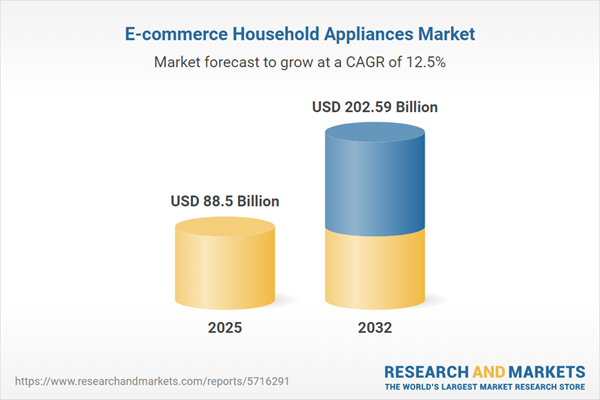Speak directly to the analyst to clarify any post sales queries you may have.
Senior decision-makers in the household appliances industry face a rapidly shifting ecommerce landscape, driven by digital transformation, evolving consumer expectations, and new supply chain complexity. As competition intensifies across mature and emerging markets, understanding key market dynamics becomes essential for strategy development and risk mitigation.
Market Snapshot: E-commerce Household Appliances Market Growth
The E-commerce Household Appliances Market grew from USD 79.10 billion in 2024 to USD 88.50 billion in 2025. It is projected to expand at a CAGR of 12.47%, reaching USD 202.59 billion by 2032. Sustained digital adoption, increased comfort with online channels, and consumer demand for integrated, tech-enabled appliances are fueling this robust trajectory. Growth is equally supported by advanced ecommerce platforms offering improved logistics, flexible payment systems, and enhanced online experiences.
Scope & Segmentation
- Product Types: Kitchen appliances, including blenders, coffee makers, grillers, and toasters; large appliances such as air conditioners, refrigerators, and washing machines; and small appliances like air fryers, food processors, and microwaves.
- Brand Categories: Premium brands focused on design, durability, and smart features; private label brands targeting cost-sensitive buyers seeking value and reliability.
- Energy Efficiency: Appliances that are Energy Star certified as well as non-certified options to address varying degrees of environmental consciousness.
- End Users: Residential buyers driven by lifestyle and aesthetics; commercial clients covering cafes, restaurants, and shops.
- Distribution Channels: Brick and mortar stores, specialty outlets, and online retailers, each contributing distinct customer experiences and fulfillment models.
- Regional Coverage:
- Americas—North America (United States, Canada, Mexico); Latin America (Brazil, Argentina, Chile, Colombia, Peru).
- Europe, Middle East & Africa—Europe (United Kingdom, Germany, France, Russia, Italy, Spain, Netherlands, Sweden, Poland, Switzerland); Middle East (United Arab Emirates, Saudi Arabia, Qatar, Turkey, Israel); Africa (South Africa, Nigeria, Egypt, Kenya).
- Asia-Pacific—China, India, Japan, Australia, South Korea, Indonesia, Thailand, Malaysia, Singapore, Taiwan.
- Leading Companies: Alibaba Group Holding Ltd., Amazon.com, Inc., AO.com, Best Buy, Croma Electronics by Tata Group, Currys PLC, eBay Inc., JD.com, Inc., John Lewis PLC, Reliance Retail Limited, Shopee Mobile Malaysia Sdn. Bhd., Shopify Inc., Target Brands, Inc., Tesco PLC, The Home Depot, Walmart, Inc., among others.
Key Takeaways for Senior Decision-Makers
- Digital transformation is redefining how consumers interact, empowering brands to deliver personalized ecommerce experiences and seamless service in a growing category.
- The blend of smart technology, eco-efficient designs, and data-driven personalization is increasing consumer engagement and influencing key purchase decisions.
- Omnichannel approaches—merging online, brick-and-mortar, experiential showrooms, and AR—are strengthening trust, speeding fulfillments, and building lasting relationships.
- Environmental concerns have shifted sustainability from a niche to a mainstream consumer priority, prompting investments in energy efficiency and recyclable materials.
- Strategic partnerships across logistics, software, and energy sectors are enabling market leaders to enhance product ecosystems and operational resilience.
- Localized strategies reflecting regional regulatory requirements and consumer trends are critical for sustained growth in diverse markets.
Tariff Impact
Recent tariff policies in the United States have prompted manufacturers and distributors to adapt by reassessing sourcing and shifting toward regional production to control costs and reduce exposure to currency risks. Retailers are optimizing supply agreements and logistics partnerships to manage price changes, while consumers benefit from promotions intended to soften pricing pressures. These developments have accelerated automation investments and encouraged new collaborations throughout the value chain.
Methodology & Data Sources
This report leverages a dual research approach, combining interviews with C-level executives and procurement leads from major manufacturing, ecommerce, and logistics firms, alongside a critical review of industry publications, regulatory filings, and trade show insights. The data is triangulated and validated through analytics and scenario mapping, delivering robust, actionable intelligence tailored for your strategic needs.
E-commerce Household Appliances Market: Why This Report Matters
- Provides senior leaders with targeted insights to inform investment, procurement, and go-to-market strategies across rapidly changing digital and physical channels.
- Equips decision-makers with regional and segment-based intelligence, enhancing competitiveness in a fragmented but growing global market.
Conclusion
The household appliances ecommerce sector is experiencing rapid evolution shaped by digital innovation, changing user demands, and shifting regulatory contexts. Informed strategies anchored in solid research will be critical to capitalize on emerging opportunities and mitigate evolving risks in this complex landscape.
Additional Product Information:
- Purchase of this report includes 1 year online access with quarterly updates.
- This report can be updated on request. Please contact our Customer Experience team using the Ask a Question widget on our website.
Table of Contents
3. Executive Summary
4. Market Overview
7. Cumulative Impact of Artificial Intelligence 2025
Companies Mentioned
The companies profiled in this E-commerce Household Appliances market report include:- Alibaba Group Holding Ltd.
- Amazon.com, Inc.
- Antista AS
- AO.com
- Argos Limited
- Best Buy
- Costco Wholesale Corporation
- Croma Electronics by Tata Group
- Currys PLC
- eBay Inc.
- FNAC QATAR
- Inter IKEA Group
- JD.com, Inc.
- John Lewis PLC
- Lan Mark Shops India Private Limited
- myG India Private Limited
- Reliance Retail Limited
- Shopee Mobile Malaysia Sdn. Bhd.
- Shopify Inc.
- Target Brands, Inc.
- Tesco PLC
- The Home Depot
- Ubuy Co.
- Walmart, Inc.
Table Information
| Report Attribute | Details |
|---|---|
| No. of Pages | 189 |
| Published | November 2025 |
| Forecast Period | 2025 - 2032 |
| Estimated Market Value ( USD | $ 88.5 Billion |
| Forecasted Market Value ( USD | $ 202.59 Billion |
| Compound Annual Growth Rate | 12.4% |
| Regions Covered | Global |
| No. of Companies Mentioned | 25 |









